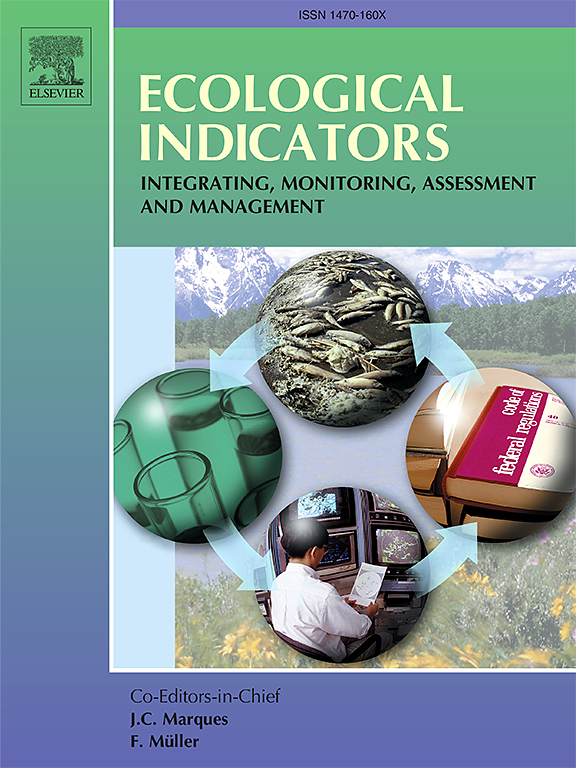Effectiveness and driving mechanisms of ecological conservation and restoration in Sichuan Province, China
IF 7
2区 环境科学与生态学
Q1 ENVIRONMENTAL SCIENCES
引用次数: 0
Abstract
Accurately monitoring and identifying the driving mechanisms behind sustainable ecosystem development is essential for formulating management strategies. In recent years, Sichuan Province has undertaken a series of initiatives designed to enhance the quality of its ecological environment. Nonetheless, there remains a significant gap in the quantitative evaluation of the effectiveness and motivating mechanisms behind these initiatives. This study aims to assess the effectiveness of ecological conservation and restoration projects (ECRPs) from 2000 to 2020 by utilizing high-precision land cover (LC) results, with a specific emphasis on the number of new additions, the ecosystem service value (ESV), and the changes in ecosystem service (ES). Furthermore, the GeoDetector model was employed to investigate the potential driving mechanisms. The results indicated that a total of 16,710.72 km2 of non-ecological land was converted into ecological land, with 81.67 % and 12.33 % of this conversion resulting in forest and grassland, respectively. Additionally, 93.08 % and 4.78 % of the newly established ecological land area originated from cropland and barren, respectively. The newly added ecological land contributed a cumulative total of 57.752 billion CNY yuan in ESV, with adjustment and support services accounting for a combined total of 90.74 %. The transitions from cropland to forests and waters contributed 42.953 and 7.371 billion yuan, respectively. The spatial patterns of carbon storage (CS), soil retention (SR), and water yield (WY) were more aligned with the area distribution of ecological restoration regions (ERRs). CS, SR, and habitat quality (HQ) indices exhibited varying degrees of increase within the ERRs across each county, while WY experienced a decline. Natural conditions, demographic changes, and climatic characteristics significantly impacted the implementation of ECRPs. The observed divergent characteristics emerged from the interplay of multiple factors, with these effects being more pronounced under the influence of these interacting elements.

四川省生态保护与修复成效及驱动机制
准确监测和确定可持续生态系统发展背后的驱动机制对于制定管理战略至关重要。近年来,四川省采取了一系列旨在提高生态环境质量的举措。尽管如此,在对这些倡议的有效性和激励机制进行定量评价方面仍然存在重大差距。利用高精度土地覆盖(LC)数据,对2000 - 2020年生态保护与恢复项目(ecrp)的有效性进行了评价,重点分析了新增项目数量、生态系统服务价值(ESV)和生态系统服务价值(ES)的变化。此外,利用GeoDetector模型探讨了潜在的驱动机制。结果表明:全年共有16710.72 km2的非生态用地转化为生态用地,其中81.67%转化为森林,12.33%转化为草地;新增生态用地的93.08%为耕地,4.78%为荒地。新增生态用地累计贡献社会经济价值577.52亿元,其中调整与支持服务合计贡献社会经济价值90.74%。退耕还林和退耕还水分别贡献4295.3亿元和73.71亿元。碳储量(CS)、土壤保有量(SR)和产水量(WY)的空间格局与生态恢复区(ers)的面积分布更为一致。CS、SR和生境质量(HQ)指数在各县域ERRs内均有不同程度的上升,而WY呈下降趋势。自然条件、人口变化和气候特征显著影响了ecrp的实施。所观察到的不同特征是多种因素相互作用的结果,在这些相互作用因素的影响下,这些影响更加明显。
本文章由计算机程序翻译,如有差异,请以英文原文为准。
求助全文
约1分钟内获得全文
求助全文
来源期刊

Ecological Indicators
环境科学-环境科学
CiteScore
11.80
自引率
8.70%
发文量
1163
审稿时长
78 days
期刊介绍:
The ultimate aim of Ecological Indicators is to integrate the monitoring and assessment of ecological and environmental indicators with management practices. The journal provides a forum for the discussion of the applied scientific development and review of traditional indicator approaches as well as for theoretical, modelling and quantitative applications such as index development. Research into the following areas will be published.
• All aspects of ecological and environmental indicators and indices.
• New indicators, and new approaches and methods for indicator development, testing and use.
• Development and modelling of indices, e.g. application of indicator suites across multiple scales and resources.
• Analysis and research of resource, system- and scale-specific indicators.
• Methods for integration of social and other valuation metrics for the production of scientifically rigorous and politically-relevant assessments using indicator-based monitoring and assessment programs.
• How research indicators can be transformed into direct application for management purposes.
• Broader assessment objectives and methods, e.g. biodiversity, biological integrity, and sustainability, through the use of indicators.
• Resource-specific indicators such as landscape, agroecosystems, forests, wetlands, etc.
 求助内容:
求助内容: 应助结果提醒方式:
应助结果提醒方式:


